
http://www.iaeme.com/IJM/index.asp 15 editor@iaeme.com
International Journal of Management (IJM)
Volume 8, Issue 5, Sep–Oct 2017, pp.15–30, Article ID: IJM_08_05_003
Available online at
http://www.iaeme.com/ijm/issues.asp?JType=IJM&VType=8&IType=5
Journal Impact Factor (2016): 8.1920 (Calculated by GISI) www.jifactor.com
ISSN Print: 0976-6502 and ISSN Online: 0976-6510
© IAEME Publication
IMPACT OF HRD CLIMATE ON EMPLOYEE
ENGAGEMENT IN SELECT DEFENCE PUBLIC
SECTOR UNDERTAKINGS
Dr. LVSN Murthy
Manager (P&A), Bharat Dynamics Limited, Hyderabad, India
Dr. (Mrs.) G Manchala
Professor & Dean, Academics,
Vignan Jyothi Institute of Management, Hyderabad, India
ABSTRACT
HRD climate is indispensable for developing human resources in any
organization. Employee Engagement is meant for motivating the employees for giving
their best effort to achieve the organizational success. In this paper, an effort is made
to find out the relation between HRD Climate and Employee Engagement which are
different in its concepts. However, a positive relationship is established between these
two, Hence the study is educative and interesting for academicians, research scholars
in the field.
Key words: Human Resource Development (HRD), Employee Engagement (EE),
Defence Public Sector Undertakings (DPSUs), Public Sector Undertakings(PSUs),
Indian Oil Corporation (IOC), Oil and Natural Gas Company (ONGC), Bharat
Dynamics Limited(BDL), Mishra Dhatu Nigam(Midhani), Bharat Dynamics
Limited(BEL).
Cite this Article: Dr. LVSN Murthy and Dr. (Mrs.) G Manchala, Impact of HRD
Climate on Employee Engagement in Select Defence Public Sector Undertakings.
International Journal of Management, 8 (5), 2017, pp. 15–30.
http://www.iaeme.com/IJM/issues.asp?JType=IJM&VType=8&IType=5
1. INTRODUCTION
Organizations are indispensable for economic and social transformation and for stable social
functioning. Public Sector Organizations seek to achieve commanding heights of national
economy. Therefore, organizations need to have different resources. These resources include
people in the organization called human resources. They receive greater importance over and
above any other resources in any organization. Employees form most important components
of any organizational set up. Mangers have to prepare and develop employees (people) to
achieve the goals of the organization. Hence, there is a necessity to develop the employee to
meet the organizations goal. This is known as Human Resource Development (HRD).

Dr. LVSN Murthy and Dr. (Mrs.) G Manchala
http://www.iaeme.com/IJM/index.asp 16 editor@iaeme.com
Organizations today increasingly recognize the potential of their employees as a source of
competitive advantage (pfeffer, 1998)1. With intensified global competition, highly targeted
workforces, and pressure for continuing strides in workers’ productivity, the employee has
become the keystone in achieving business results. It is repeatedly proven and reinforced that
employees are undoubtedly the most valuable asset and the correct employee policies make
the bottom- line difference. Creating this advantage through employees requires a careful
attention to the practices that can best leverage the Human Capital. However, organizations
are falling short to unleash the talents and motivations of their employees to achieve peak
performance (Katzenbach, 2000)2. Recent efforts to improve the organizational performance
have begun to emphasize positive organizational behavior concepts and positive emotions.
The quest has turned the attention of some researchers to a relatively new model called
Employee Engagement (Steelman, Maszal, Newbolt & Churchwell, 2002)3; (Cameron et al,
2003)4.
2. STUDIES ON RELATIONSHIP BETWEEN HRD CLIMATE AND
EMPLOYEE ENGAGEMENT
Analysis of Hewitt Associates5 (29 Jul 2010) stated that there was steady decline in
Global Engagement levels. According to them this is a largest drop in the engagement levels
that was observed during past 15 years. This indicates that there is a necessity to have some
concrete mechanism to improve engagement levels of employees in Organizations.
Organizations are in dire need to improve engagement levels of organization. Thus, the
importance of Human Resource Development (HRD) climate cannot be overlooked.
Therefore, there is a need to examine the relationship between dimensions of HRD climate
and Employee Engagement in Defence Public Sector Undertakings based at Hyderabad in
Telangana State.
Various HRD models have been proposed to gain competitiveness by the organization
through human capital (DeGeus (1997)6; McCracken and Wallace (1997)8. The models
specify investment in HRD by organizations and individuals is crucial to build and retain that
resource in the future. Therefore, organizations look for development of employee
competencies through sophisticated human resource development strategies (Losey (1999)9;
(Spangenberg, Schroder, & Duvenge, 1999)10.
Employee engagement has came out as one of the tool to measure their investment in
human capital and also to measure employee commitment to the organization and as a way of
creating a more effective workplace (Echols, 2005)11.
In the present economic climate, the employee’s psychological connection to their work is
certainly a key to effectively compete. The organizations are in dire need to have employees,
who are engaged with their work (Bakker & Leiter, 2010)12. There is substantial amount of
research evidence to demonstrate the importance of engagement for bottom line outcomes
such as job performance (Bakker & Bal, 2010)13; (Halbesleben & Wheeler, 2008)14, client
satisfaction (Salanova, Agut, & Peiro, 2005)15, and financial returns (Xanthopoulou, Bakker,
Demerouti, & Schaufeli, 2009b) 16.
With the increasing in momentum for study of employee engagement, researchers are
increased their focus on what factors have exactly causing employee engagement and how it
can be improved. However, it is disappointing to note that little research has been undertaken
in this direction; identifying the antecedents of employee engagement needs to attract
considerably more attention.

Impact of HRD Climate on Employee Engagement in Select Defence Public Sector Undertakings
http://www.iaeme.com/IJM/index.asp 17 editor@iaeme.com
There was no theoretical base is existing for the causal relationship between HRD climate
and Employee Engagement. Independently both are relating to improved performance of the
individuals and to have a psychological relationship exists with the Organization. Therefore,
both are leading to improved performance to attain the objectives of the organization in turn
leads to organizational effectiveness and increases in organizational prosperity. Therefore,
researchers are concentrating to study the fundamental relationship, whether existing in these
two distinct subjects. The studies on finding the relationship between these are scarce.
3. NEED FOR THE STUDY
The select DPSUs are the prominent organizations in manufacturing of defence equipments
and allied products to cater the defence and security needs of the country. The performance of
these DPSUs are quite commendable, it has become a routine for these industries to win
national awards from Government of India in their respective field of manufacturing.
It is to mention that PSUs are the foremost units in spending huge amounts of money on
human resources development. It is a fact that the attainment of objectives of the
organizations significantly depends upon the development of its human resources. In other
words, human resources are the major contributory factor in enhancing the efficiency and
productivity result into profitability to the organizations. Further, it is an undisputed fact that
no firm or company or institution in any part of the globe can attain any mission, objective,
goal or target without human resources development. Above, all it helps in developing good
human relations. As stated in preceding sections HRD is a process by which employees are
continuously helped in a planned way to acquire all-round capabilities where team work and
collaboration contribute to the organizational health. Thus HRD helps in improving good
human relations and positive organizational climate; thereby it helps in attaining the
organizational goals economically and effectively.
Further, positive organizational climate enhances engagement levels of the employees’
leads to retention of the employees. Engaged employee commited to work for achievement of
organizational goals. Therefore, organizations need to have engaged work force for improving
productivity and better organizational performance.
Hewitt Associates2 reported that there was steady decline in Global Engagement levels.
According to them this is a largest drop in the engagement levels that has been observed in the
last 15 years. This indicates that there is a necessity to have some concrete mechanism to
improve engagement levels of employees in Organizations. Organizations are in dire need to
improve engagement levels of its employees. Thus, the importance of Human Resource
Development (HRD) climate can not be overlooked.
Due to growing popularity of Employee Engagement, a considerable body of literature has
come up over the years, examining various aspects of engagement at the macro and mircro
levels. However, the literature invented by consulting firms remained largely descriptive and
lacked academic perspective. Researches have started academically analyzing the concept
seriously, since 1990 only. It is surprising to note that most of studies have been carried out in
the developed countries. Such studies conspicuously lacked the Indian Context. A few studies
have been undertaken to assess the levels of Employee Engagement in India but not in
Defence Public Sector undertakings.
Further, many international research and consulting firms such as Hewitt Associates,
Gallup has undertaken research on engagement of Indian firms. It is an observable fact that
the big corporations of private sector and few public sector corporations such as Indian Oil
Corporation (IOC), Oil and Natural Gas Company (ONGC) are conducting this type of study

Dr. LVSN Murthy and Dr. (Mrs.) G Manchala
http://www.iaeme.com/IJM/index.asp 18 editor@iaeme.com
with the help of international consulting and research organizations to take corrective
measures in the human-managerial and organizational fronts . There is no need to say that ,
research on engagement in other public sectors such as heavy engineering and heavy industry
sector’s organizations found scanty and the researcher even unable to cite any evidence on
these sector at the start of the study(Anita Singh et al 2013)17. The need for public sector
organizations to improve the way in which they manage change and develop leadership
capability has highlighted by Ipsos Mori (2006)18 in his study. Hence, it is necessitated to
study employee engagement in these DPSUs also.
By and large Indian Organizations view HRD climate is combination of three dimension
namely, General Climate, HRD Mechanisms and OCTAPACE culture. These organizations
have increasingly realized the need for changing their culture & climate and attitude of its
employees for which they relying on HRD climate.
The study intends to correlate HRD climate Dimensions scores with Employee
Engagement Scores prevailing in the DPSUs. This will be done to know whether they are
correlated or not and to know further the nature and degree of relationship between HRD
climate dimensions and Employee Engagement levels.
Since the problem of study has been identified by the researcher on the basis of existing
stock of researches in the field of HRD and Employee Engagement in general and Defence
PSUs in particular, it is expected that the study will fill up the gaps to some extent in
addressing the importance of HRD climate & Employee Engagement in DPSUs.
This leads to effective Employee Engagement which will be in turn leads to attraction and
retention, thereby improved organization effectiveness and performance.
Thus, such relationship provide a clear picture of the nature, type and degree of
relationship between the two concepts HRD climate and Employee Engagement as these
relationship will provide input for the development of HRD climate and Engagement models
in Defence PSUs.
Moreover, the conclusions of the study are expected to go a long way in developing the
favorable HRD climate for development of manpower and Employee Engagement in a more
meaning full manner as the perceptions of executives and non executives represent their
actual feelings, experience and reactions regarding the HRD climate and EE. From this point
of view , the conclusions of the study will add to the existing knowledge on the HRD Climate
and Employee Engagement and will become a further sound base for future researches in this
field.
4. A CRITICAL ANALYSIS OF REVIEW OF LITERATURE
It was observed that many international research and consulting firms such as Hewitt
Associates, Gallup has undertaken research on Employee Engagement of only few Indian
public sector corporations such as Indian Oil Corporation (IOC), Oil and Natural Gas
Commission (ONGC) for taking corrective actions in the human-managerial and
organizational fronts.
Further, research on engagement in other public sector such as heavy engineering and heavy
industry sector’s organizations found scanty and the researchers even unable to cite any
evidence on these sectors at the start of the study.
Ipsos Mori (2006)18 has highlighted the need of PSUs to improve the way in which they
manage change and develop leadership capability for organizational effectiveness.

Impact of HRD Climate on Employee Engagement in Select Defence Public Sector Undertakings
http://www.iaeme.com/IJM/index.asp 19 editor@iaeme.com
Steady decline in Global Engagement levels observed in the last 15 years, necessitated some
concrete mechanism to improve engagement levels of employees in Organizations, therefore
there is a dire need to improve engagement levels of its employees. Hence, importance of
Human Resource Development (HRD) climate can not be overlooked to improve the
Employee Engagement levels.
Hence, there is a research gap on Relationship between HRD Climate and Employee
Engagement studies also in PSUs particularly in select DPSUs.
5. RESEARCH GAPS
Efforts were made to critically review the literature on relationship between HRD climate and
Employee Engagement. The following efforts are made to find the research gaps that existed
in HRD climate and Employee Engagement in Indian industries.
There is no significant study on proper linking of HRD climate and Employee Engagement.
Further, research studies on relationship between HRD Climate and Employee Engagement in
public sector domain found very little and the researchers even unable to quote any evidence
on these sector particularly in Defence Manufacturing Sector. Hence there is a gap of this
study. The study will enable the researchers and Industry personnel to improve their strategies.
5.1. Research Studies on relationship between HRD climate and Employee
Engagement
Lau & May (1998)19 suggested that companies with a higher quality of work environment
(e.g., opportunity for career growth, a culture of support and openness) tend to have higher
profits and business success compared to companies with a poor quality of work environment.
Studies have also demonstrated the importance of a climate of trust for positive workplace
behaviours and attitudes (Dirks & Ferrin, 2002)20.
Robinson, Perryman & Hayday (2004)21 reported that the employees who are having personal
development plans and annual formal performance appraisals will have greater engagement
levels than those who do not have development plans.
Demerouti, Bakker, Nachreiner, & Schaufeli, 200122; Schaufeli & Bakker, 200423 , Salanova
et al., 200524;, in their study of Job-Demand–Resource (JD–R) model the work environment
can be divided into job demands and job resources which relate differently to well being and
attitudinal outcomes (Bakker et al., 2003149, 2005150; Demerouti et al., 200122; Hakanen23 et
al., 2006; Llorens24et al., 2006; Salanova25 et al., 2005; Schaufeli & Bakker, 2004; Bakker &
Demerouti 2007).
From the large number of studies, it was shown that job resources like autonomy, social
support, supervisory coaching, performance feedback, participation in decision making and
opportunities for learning, training, professional development, were related positively with
employee engagement (Hakanen, Bakker, & Schaufeli, 200626; Saks27,2006; Xanthopoulou28
et al., 2007, Bakker29 et al., 2003; Demerouti30 et al., 2001).
Hakanen, Bakker, Schaufeli151, 2006 et.al , in a study on Finnish teachers, job resources such
as job control, supervisory support and good organizational climate were reported to be
positively associated with work engagement..
Bakker, Hakanen, Demerouti & Xanthopoulou (2007)155 in a study among Finnish school
teachers reported that supervisory support, positive appreciation, collaborative organizational
climate, and innovative problem solving correlated positively with engagement.


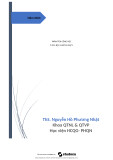

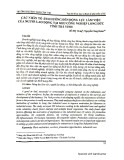
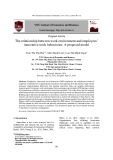


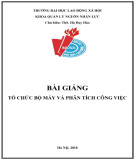
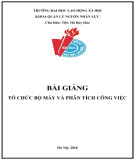





![Văn hóa công vụ: Tài liệu những vấn đề chung [chuẩn nhất]](https://cdn.tailieu.vn/images/document/thumbnail/2025/20250821/vyvy108@gmail.com/135x160/70301755829982.jpg)


![Tài liệu Nhập môn tội phạm học [chuẩn SEO]](https://cdn.tailieu.vn/images/document/thumbnail/2025/20250803/sea2che@gmail.com/135x160/20461754291783.jpg)







